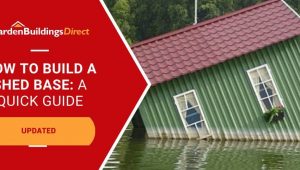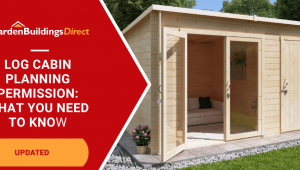Jump to:
Interior wall cladding is a great idea for garden sheds. When you want to customise your shed, the interior walls offer a huge amount of potential to improve your shed experience, including changing it into a different type of room.
In this guide, we’ll explain how cladding can improve your shed and list the best materials to get the job done. Ready?
The Benefits of Interior Wall Cladding
First things first, internal cladding is a material that covers a building from the inside, acting as a ‘skin’. That’s the basic idea, but here’s what it offers:
Shed insulation
An extra layer of cladding provides the opportunity to place insulation material such as foam or expanded polystyrene in between the outer and inner walls, improving the structure’s thermal resistance. This means heat stays in during winter and out during summer. Plus, it helps save on energy if you’re using heating or cooling, and you might not even need to use them anymore.
Insulation is best paired with extra thickening of the floor and ceiling, not to mention double glazed windows if you really want to transform your shed into a full-fledged garden room to use all the time.
Better interior wall surface
A smooth, finished wall inside the shed gives you more freedom to personalise it. That’s what you get with cladding—a clean surface that’s ready for shelves, hooks, or anything else you might want to add. Painting is also much easier with these best shed paint colours.
Protect the shed walls
As a protective layer, cladding shields the walls from dents, scratches, and moisture damage. This means that only the exterior of a wooden shed will continue to need anti-rot treatment. Most materials resist wear and tear, while some are even pre-treated to resist weathering and fading. Overall, this results in minimal effort required over time.
Best Materials for Shed Interior Walls
Your chosen material should be strong enough to support the ways you plan to use your new space.
Plywood

Plywood is a good choice for lining the inside of a small shed. It’s tough and durable, allowing you to install shelves, hooks, or other items to the walls once it’s up. It comes in different thicknesses, from 3.6mm to 18mm. If you’re after something more sturdy with better insulation, we’d suggest going for thicker ones.
Drywall

(Image Credit: Flickr, Olger Fallas Painting)
Drywall gives your shed a smooth, clean finish that looks great. You can paint it in any colour or texture you like, or even cover it with wallpaper to personalise the space. It’s also more fire-resistant than plywood, which makes it a strong option.
Note: Drywall is best if your shed has a vapour barrier. It absorbs moisture, so without it, it might get damaged.
OSB

OSB (Oriented Strand Board) is made of layers of chipped-up lower-grade wood. It resists warping and offers consistent strength across the board. Even better, the board can withstand moisture exposure. It has a flaky appearance and bumpy texture, though. If you don’t mind the look, it makes a cost-effective option.
Beadboard
Beadboard is a wood panelling featuring long, continuous vertical grooves and raised beads. It is made of fibre cement, giving you a natural wood panelling look.
This material resists twisting and decay, and it also keeps wood-damaging insects, like termites, away from your shed. It’s a great alternative if your wooden walls have experienced termite problems before.
It’s a little more expensive than wood, but it’s safer, lasts longer, and requires less maintenance overall.
Upcycled pallets
Pallets are a cost-effective option for creating an interior wall in your shed. If you’re going this route, make sure the pallets are safe for indoor use.
Look for the IPPC marking, which ensures the wood is free from insects and diseases. Also, pallets marked with HT (heat-treated) or KD (kiln-dried) are safe and won’t pose any harm to your health.
Avoid pallets with markings like the MB (Methyl Bromide) stamp, as well as those with CP1, CP2, CP3, CP4, and CP5 markings. These are used in the chemical industry.
Round-up
Interior wall cladding gives your shed (or garden workshop) better insulation and a more durable wall surface, with minimal maintenance required over time. If you’re taking the DIY route, your best options for cladding materials are plywood, drywall, OSB, beadboard, and upcycled pallets.
A bit of DIY know-how and patience can help if you’re doing this yourself. But you can always seek professional help if the process requires more expertise than you’re comfortable with.
Need more shed advice? Check out our expert sheds guide for more information.





